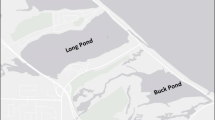Abstract
Archimedes' principle can be effectively applied to measure the mass and volume of small aquatic organisms by weighing the organism in waters of two densities, and then comparing those values with the weights of a plummet weighed in the same waters. However, the weight-in-water measurements are subject to error, and this work outlines how to calculate the standard errors of organism mass and volume, and a straightforward approach to calculating organism mass and volume itself. Guidance for the design of a plummet and setting a water density difference that minimizes the standard errors of the measurements is also presented.
Similar content being viewed by others
References
Barford, N. C., 1985. Experimental measurements: Precision, error, and truth. John Wiley and Sons, New York, 159 pp.
Coombs, S. H., 1981. A density-gradient column for determining the specific gravity of fish eggs with particular reference to eggs of the mackerel Scomber scombrus. Mar. Biol. 63: 101–106.
Darling, M. S. & K. M. Wilbur, 1993. A method for measuring growth in living barnacles (Crustacea, Cirripedia). J. mar. biol. Ass. U.K. 73: 723–726.
Fine, M. L., J. W. McKnight & C. R. Blem, 1995. Effect of size and sex on buoyancy in the oyster toadfish. Mar. Biol. 123: 401–409.
Gee, J. H., 1981. Coordination of respiratory and hydrostatic functions of the swimbladder in the central mudminnow, Umbra limi. J. exp. Biol. 92: 37–52.
Gee, J. H. & H. M. Holst, 1992. Buoyancy regulation by the sticklebacks Culaea inconstans and Pungitius pungitius in response to different salinities and water densities. Can. J. Zool. 70: 1590–1594.
Gee, J. H. & R. C. Waldick, 1995. Ontogenetic buoyancy changes and hydrostatic control in larval anurans. Copeia 861–870.
Gee, J. H. & P. A. Gee, 1995. Aquatic surface respiration, buoyancy control and the evolution of air-breathing in gobies (Gobiidae: Pisces). J. exp. Biol. 198: 79–89.
Power, J. H., W. L. Morrison & J. Zeringue, 1991. Determining the mass, volume, density, and weight in water of small zooplankters. Mar. Biol. 110: 267–271.
Power, J. H. & P. J. Walsh, 1992. Metabolic scaling, buoyancy, and growth in larval Atlantic menhaden, Brevoortia tyrannus. Mar. Biol. 112: 17–22.
Taylor, J. R., 1981. An introduction to error analysis: The study of uncertainties in physical measurement. University Science Books, Mill Valley, California, 270 pp.
Wildish, D. J. & B. Frost, 1991. Volumetric growth in gammaridean amphipoda. Hydrobiologia 223: 171–176.
Author information
Authors and Affiliations
Rights and permissions
About this article
Cite this article
Power, J.H. Errors associated with using Archimedes' principle to determine mass and volume of small aquatic organisms. Hydrobiologia 335, 141–145 (1996). https://doi.org/10.1007/BF00015275
Received:
Revised:
Accepted:
Issue Date:
DOI: https://doi.org/10.1007/BF00015275




